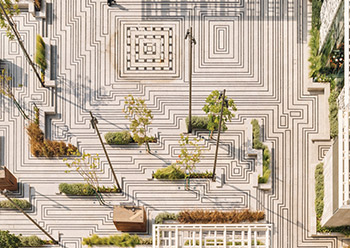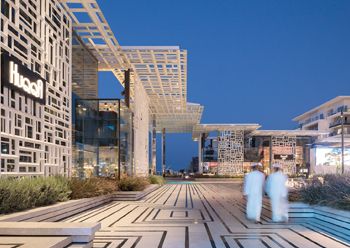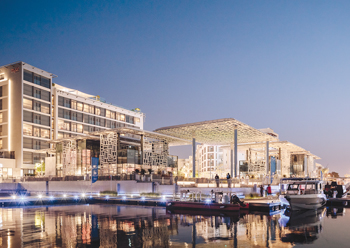Urban attraction
Marsa Plaza, Oman’s largest new urban square which opened last year, has been designed with Omani materials and patterns, providing a space that is contemporary in form but deeply rooted in the local context.
01 July 2020
ACME, a UK-based specialist in contemporary architecture, urban planning and interior design, says its recently completed Marsa Plaza, Oman’s largest new urban square, has quickly become the beating heart of Al Mouj Muscat, one of the sultanate’s largest latest developments that define a new urban quarter of the capital.
The leisure and cultural destination has been conceived as the heart of the Marina District, linking the main boulevard to the seafront promenade. It is intended to be not just an amenity for the local community, but also a destination for the wider public of the capital Muscat, which is tightly wedged between the Gulf of Oman and the Al Hajar mountain range behind.
Situated in the centre of Al Mouj Quarter, on the western side of Muscat, the 5,500-sq-m Marsa Plaza creates a new urban space at the edge of the marina comprising a 3,500-sq-m public plaza and 1,050 sq m of restaurants and cafes with terraces.
Opening out into the water and defined by steps and shading canopies, the square creates a number of informal spaces for water features and people-watching, seating terraces and an amphitheatre for performances.
 |
|
Steps in the square and joints are outlined in black granite. |
The ground plane of the square, the walls of the buildings and the shading canopies have all been designed as one to create a unified visual spatial identity and to blur the boundaries between the separate elements. The materiality and patterns have been developed from the local context, using local Omani stone and patterns developed from traditional geometries and vernacular types.
Protected from the intense sunlight by trees and overlapping canopies, the new plaza invites people of all ages and creates a shaded environment for use during the heat of the day and in the evening. The screen patterns have been designed to maximise shading, depending on screen angle and exposure, with variations in the grid to balance light and shade for each position.
Friedrich Ludewig, Director at ACME, says: “Marsa Plaza was envisioned as the new heart of the Al Mouj community, providing green shade, spaces to sit, talk, eat, play and enjoy the breeze from the sea. Designed with local Omani materials and patterns and built with local contractors, the space is contemporary in form but deeply rooted in the local context.
“The spaces created by the structured floor, walls and canopies are simple to construct yet jointly create a complex and memorable space and identity for the community.”
 |
|
The space is contemporary in form but deeply rooted in the local context. |
“The levels of the square are stepped and ramped to bring the city closer to the water’s edge and to form a natural amphitheatre around the central water feature. The geometry of the paving, canopies and mashrabiya wall plays with the tectonics and graphics of traditional Omani architecture,” explains Ludewig.
The project is constructed from solid local stone – Desert Rose marble quarried in Oman. Steps in the square and joints are outlined in black granite to create the floor pattern, and locally-produced lightweight aluminium canopies and screens cover the outside seating areas.
Two restaurants occupy the space behind some of the shading screens and have been visually divided into three separate volumes: a double-height glazed volume, a single-storey volume with roof terrace and a stone-clad kitchens volume.
The shifting masses break up the scale of the buildings and create a variety of outdoor seating areas as well as allowing the cool sea breeze to flow into the square, he points out.
“The glazed facades are protected from the sun by screens and canopy overhangs that allow for a pleasant micro-climate inside and reduce the need for climate control,” explains Ludewig.
Roof canopies provide shading on all sides of the plaza. The canopies are lowest away from the sea, rising up towards the south-most corner where the largest one covers a performance area and frames views towards the water.
“Over the first summer, we have greatly enjoyed watching flaneurs pass by, restaurant guests eating out on the terraces, crowds of children play in the fountains, and to see performances on the stage facing the sea. We are delighted that Marsa Plaza has so quickly become the new heart of the community,” he remarks.
Al Mouj Muscat CEO Nasser Al Sheibani comments: “Marsa Plaza is a space that is both very traditional in its purpose and very contemporary in its vision, further reinforcing our commitment to offer locally relevant design and outstanding lifestyle experiences. It is already an iconic landmark for Al Mouj Muscat, a space that brings people together for shared moments, while also opening a sense of connection to the heritage and landscape of Oman. In bringing life to Marsa Plaza, we have paid careful attention to the smallest of details, successfully fulfilling the diverse leisure and cultural needs at the heart of our diverse community.”
Al Mouj Muscat is the sultanate’s premier lifestyle and leisure destination, being built as a public-private venture between the Government of Oman and the UAE-based Majid Al Futtaim Properties.
Spread along a 6-km stretch of Muscat’s coastline, this world-class integrated tourism complex (ITC) comprises a group of luxury residential properties including villas, townhouses and apartments, commercial units, retail and dining facilities, and the sultanate’s only signature PGA-standard 18-hole links golf course, designed by Greg Norman.
Al Mouj Muscat is also home to the 400-berth Al Mouj Marina – Oman’s largest private yachting hub – and The Walk, a 70-unit retail area which forms the commercial and leisure hub of the community, apart from Muscat’s first public square, Marsa Plaza. The phased development will see even more residential, leisure and hospitality offerings.
ACME, based in London (UK), Berlin (Germany) and Dublin (Ireland), has undertaken more than 220 projects in 25 countries, across a wide range of functions – from palaces to parks, offices to museums, bridges to shopping malls, housing to sports facilities, car parks to power stations.
The practice has won a number of international awards and competitions. Recent awards include Riba National Awards, the Mipim World’s Best Shopping Centre Award and the Riba Yorkshire 2017 Project of the Year Award for Victoria Gate, the ICSC Best of the Best Award and the 2010 Manser Medal for the best house of the year for Hunsett Mill in Norfolk.



